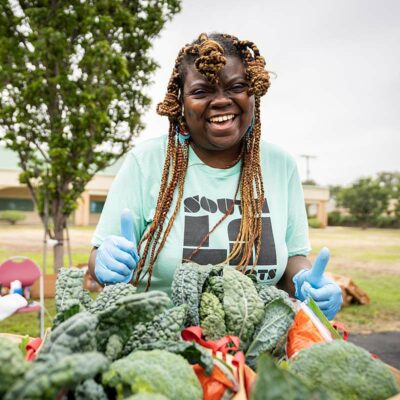For Humanity

Veganism is as much about people as it is about animals and the environment. For example, our dietary choices affect global food supply and prices, and therefore impact the ability of people everywhere to access sufficient nutritious food.
They also affect individual workers who are exploited and harmed in the production of certain foods, while animal farming affects the whole of humanity through the emergence of diseases with pandemic potential and antibiotic-resistant pathogens. In all cases, animal agriculture has a serious detrimental impact.
ANTIBIOTIC RESISTANCE
Most farmed animals on the planet are kept inside intensive farming systems. This means that large numbers of stressed, immunocompromised animals are crammed together inside vast warehouse-style barns, often living in their own filth. Unsurprisingly, in these conditions, illness and injury are rife. Instead of improving conditions, the animals are fed antibiotics to keep as many as possible alive. Globally, two-thirds of all medically important antibiotics are given to farmed animals, and this reckless waste allows superbugs to emerge. Each year, drug-resistant bacteria sicken 2.8 million Americans, with 35,000 losing their lives.
FACTORY FARMS ARE PANDEMIC FACTORIES
Our long history of exploiting animals for their meat, milk, eggs, and skins means there is also a long history of “zoonotic diseases”—diseases that transmit from animals to people. Currently, three-quarters of all emerging infectious diseases in people originated in animals, including H1N1 “swine flu,” which infected around 60.8 million people in its first year, and H5N1 “bird flu,” which kills 60 percent of all people infected. Virologists have been warning about factory farms for a very long time, with campaigners calling them “ticking time bombs” in terms of their pandemic potential.
WORKERS’ HEALTH AND RIGHTS
Exposure to chemicals, toxic gases from slurry decomposition, and the high levels of particulate matter that can cause respiratory conditions are all common hazards on animal farms. Given the dangers and poor pay, it may come as little surprise that 73 percent of farmworkers in the US are immigrants. In slaughterhouses, one-third of workers are undocumented immigrants, making them more vulnerable to exploitation. The long hours, repetitive work, moving machinery, fast-moving slaughter lines, sharp knives, and captive bolt guns make a dangerous combination. Poultry workers are routinely denied bathroom breaks, leaving many with no choice but to wear diapers or urinate on themselves, their dignity and well-being disregarded by those who profit most.



THE COLONIZATION OF FOOD
While the story of food imposition varies from country to country, what is universally true is that the dietary landscape was changed by colonizers. In some cases, Europeans feared that Indigenous food would make them ill or weak, or that it would somehow “indigenize” them. Instead, they brought their own foods, crops, and farmed animals, and forced Indigenous peoples to work on the stolen farms and produce the foods the colonizers wanted. This led to a mass displacement of Indigenous peoples and a loss of traditional foods, ceremonies, and, in time, knowledges. Today, this legacy leaves some communities burdened with disproportionately high rates of ill-health.
ENVIRONMENTAL RACISM
This is the system whereby people of color are disproportionately impacted by environmental hazards. Vast factory farms are often sited within communities of color, which ensures cheap, poverty-waged labor. Those same communities bear the brunt of the associated environmental impacts, such as poor air and water quality. Then there is the issue of food deserts—areas with few affordable, nutritious fresh foods—and food swamps—areas with a high proportion of fast-food outlets. When taken together, we see that ill-health is too often imposed on communities of color through localized agricultural practices and through being denied access to high-quality, healthy foods.
FEEDING THE WORLD
Although we produce enough food to feed the entire global human population, more than 800 million people are still hungry. One reason is the fierce competition for resources between people and the billions of farmed animals. This pushes up the cost of grain, with the global north’s desire for meat too often winning out over the needs of others just to eat. At the heart of the issue is that animal agriculture is inherently wasteful. Pigs require 8.4kg of feed to produce just 1kg of meat, while chickens require 3.4kg. Globally, 40 percent of all arable land is now used for feed crop production, an area which, if used instead for human food cropping, could feed an additional four billion people. Choosing plant-based foods is about food equity and justice, and ensuring there is enough nutritious food for everyone.